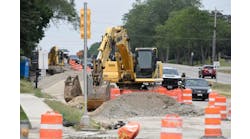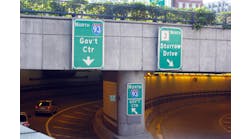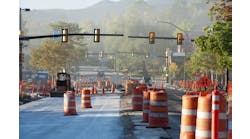Weather always plays a role in arterial asphalt and concrete resurfacing projects. Strong demands for maintaining high traffic volumes also are typical of urban roadwork, and occasionally projects are faced with unusual demands.
This is a tale of a project where overhead electric bus trolley lines, underground streetcar tracks, an interstate ramp terminus and a series of weekend festivals all played a role in a novel approach to sequencing work on the North/Northeast 45th Street project.
Working Wallingford
Seattle’s North/Northeast 45th Street is a major east-west arterial in a city where major highways follow glacier-gouged ridgelines and bodies of water running north and south. East-west routes are very heavily trafficked, with 45th Street carrying 32,000 vehicles per day between I-5 and the University of Washington campus over a six-lane cross section. A nearly equivalent number of vehicles travel on the five lanes stretching to Washington State Rte. 99, which parallels I-5 approximately 1 mile to the west. These lanes pass through the center of Wallingford, one of Seattle’s many neighborhood commercial districts deeply interested in minimizing construction impacts as Seattle rebuilds its transportation infrastructure. All this vehicular traffic shares 45th Street with a large number of buses (which rely on overhead electric trolley lines for power) on a route once used by streetcars whose steel tracks and creosote-soaked ties remain buried in places, occasionally encased in 21 in. of concrete.
The roadway itself was heavily rutted with many localized areas of alligator cracking resulting from high volumes of heavy buses. The existing pavement section consisted of a composite combination of asphalt over brick over lean concrete or asphalt over concrete. Underneath the top surface of asphalt was a layer of “Sheet Top” asphalt, which consists of asphalt oil and sand, thought to contribute to the rutting issues.
Rather than resurface the roadway by inlaying 2 in. of asphalt, the design team decided to remove 4 in. of asphalt completely in some areas in order to eliminate the streets’ top layer and get rid of the most significant rutting.
The design team also decided to repair the areas of localized failures in the concrete base with a full-depth asphalt pavement section to speed the repairs and minimize traffic disruptions. The project scope also included 12-in.-thick concrete pavement “bus pads” at existing bus stops to hold up better underneath the starting and stopping buses, curb ramps at all intersections to meet ADA requirements and upgrading of the drainage system on an adjacent street to meet water-quality code requirements.
Feeling de-energized
The need to keep the buses running in both directions on 45th Street utilizing the overhead electric bus trolley lines limited both the manner and the time in which contractors could work, since the Washington State Department of Labor and Industry restricts work within 10 ft of an energized line. Some activities, such as the grinding, could be done without de-energizing the electric lines if the equipment was retrofitted to not reach over certain heights and a variance was obtained. Other work—such as paving and using the material transfer vehicle—could only be completed when the lines were de-energized.
Since weekends were the only time there were enough diesel-powered buses to replace all the electric trolley buses on this corridor, paving work could only be done after the last buses finished their routes late on Friday night or early Saturday morning. And since the trolley buses had to be up and running before the Monday morning rush, the only available times for paving were the weekends.
Strike against it
Prior to the project construction, the mayor of Seattle announced that 45th Street topped a citizen-nominated list of the “Dirty Dozen”—the 12 worst roads in the city—which he wanted repaved as soon as possible. This focused even more attention on a project already in the public eye, just as a major setback was encountered.
Just two weeks after the construction contract was awarded, work was delayed by a regional strike by concrete batch plant operators. With other trades honoring the strike, no work could begin until the strike ended in September, the end of Seattle’s truly favorable construction season.
Determined to show progress on this “Dirty Dozen” nominee, the team set out to do concrete work all winter (although no work could occur in the Wallingford shopping district between the vital Thanksgiving to New Year’s Day shopping season). Concrete curb ramps and bus pads were installed along the length of 45th over the next several typically cool and wet months.
Heavy traffic was an issue throughout construction. The contract specifications required that all lanes of traffic be open between 2 p.m. and 8 p.m. each weekday with few exceptions. In addition, due to the presence of the electric trolley buses, traffic could not be diverted too far from their intended lanes because trolley buses only have a 9-ft swing on each side of the electric trolley wires. With heavy pedestrian traffic throughout the project and a vibrant business district wanting to maintain as much parking as possible during construction, there were major demands on the right-of-way. All of these things significantly affected production. But, even while there was pressure to show progress to a very attentive community, preparations were being made for the spring paving season.
With detours impossible, work limited to weekends and a 4-in.-deep grind of asphalt making it nearly impossible to maintain traffic following the grinding, the project needed an innovative plan. What the contractor, CA Carey Corp., developed was a carefully orchestrated sequence of events that were repeated six times as they progressed through half of each of the three phases of the project.
Three-day work week
Their plan was to grind on a Friday night, quickly identify any additional base repair that was required, and then pave back 2 in. all within a continuous weekend shift. This enabled them to re-establish traffic in the grind area Monday morning and make the necessary base repairs during the week. All the work at each I-5 ramp terminus required particularly quick turnaround, because closures had to be completed before 6 a.m. each day. Ramp restrictions complicated four of the six phases. Then, once all base repairs in a given section were completed, the final paving lift was completed in yet another weekend of electric trolley line de-energization.
With the critical-path work forced to weekends, weather became a significant factor in scheduling this work. The project team did not just have to wait for dry and warm weather, now it had to coincide with a weekend. Trying to find a dry weekend with nighttime temperatures above 45°F in the spring in Seattle is very difficult. Rain or cold forced the cancelation of the first two planned paving weekends. Finally, paving began in late March.
Unsurprisingly, as soon as Seattle’s weather gets clearer and drier, the community wants to celebrate, and a host of springtime weekend events loomed on the horizon. Contract specifications prohibited work during the University of Washington graduation or during any of several different community parades and festivals on each side of I-5. Seattle also is very keen to acknowledge opening day of boating season, which was not within the project area, but closed the major bridge between the asphalt plant and the project area, making trucking nearly impossible.
Toward the end of the project, the project team received support from the community to condense the final paving in the last two phases so the work could be done in one extra-long weekend shift. Although it was a major disruption to eliminate all parking in the business district during a weekend, the work was completed just in time for the Kiddie Parade, which was to traverse 45th Street the following weekend.
The city of Seattle, CA Carey Corp. and their paving subcontractor, Lakeside Industries Inc., not only completed the work on time and on budget, but gave the community a very high-quality overlay that will last for the next 15 years. It was through an extensive partnership with the contractor and subcontractor and a true commitment to teamwork and innovation that this project was made possible.


